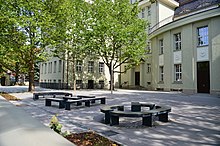Quod erat demonstrandum
The phrase quod erat demonstrandum (Latin for "what was to be proven") ties the result of a logical or mathematical argument back to the preceding purpose and thus closes the argument. It is often abbreviated as q. e. d. Especially in English, the capitalization Q. E. D. or QED based on the Latin Capitalis monumentalis is common.
origin
The phrase comes from Euclid's textbook Elements (3rd book, 4th chapter, Theorema XIII) from the 3rd century BC. And is in the ancient Greek original ὅπερ ἔδει δεῖξαι hóper édei deîxai . The Latin translation that is widespread today was shaped by the Italian humanist Bartolomeo Zamberti when he translated Euclid's elements and had them printed in Venice in 1505.
Related phrases
In the case of a claim that has yet to be proven, the words in traditional scholarly language are quod esset demonstrandum or “what needs to be proven”.
The Latin phrase quod erat faciendum is used to conclude a mathematical function .
Alternative symbol ∎
Nowadays q. e. d. also often symbolized by a black square ■. It is called tombstone , box or Halmos after the first user . Sometimes the tombstone is also shown openly: □.
Some authors use ∎ only for short proofs, but rather q for long and complicated proofs . e. d.
In Unicode , the character ∎ is encoded as End of Proof under the code point U+220E. Depending on the font, the code point is shown either as a black or empty square.
Web links
Individual evidence
- ↑ For example, in law at the end of a demonstration , see Hans Schemann: Deutsche Idiomatik. 2nd Edition. De Gruyter, Berlin, Boston 2011, ISBN 978-3-11-025940-7 , chapter "German Idiomatics", p. 122 .
- ↑ Mario Gerwig: Understanding evidence in math lessons. Springer Fachmedien, Wiesbaden 2015, ISBN 978-3-658-10187-9 , p. 120 .
- ↑ See, for example, A Flaw in the Diamond of QED. In: Science News. Vol. 111, No. 2, 1977, p. 20 (JSTOR access) .
- ^ Hubertus Kudla: Lexicon of Latin citations: 3500 originals with German translations. 2nd Edition. CH Beck, Munich 2001, ISBN 978-3-406-47580-1 , p. 45 . See for example the edition Euclidis Geometricorum elementorum libri 15: Campani in eosdem commentariorum libri 15, Theonis in tredecim priores commentariorum libri 13, Hypsiclis in duos posteriores commentariorum libri II. Estienne, Paris 1516 (digitized version ) .
- ↑ See for example Georg Christoph Lichtenberg : Correspondence. Vol. 3: 1785-1792. Edited by Ulrich Joost and Albrecht Schöne . CH Beck, Munich 1990. Letter to Lieutenant Engineer Werner zu Gießen, Göttingen, November 29, 1788, p. 616 ; Alois Hahn : Civil culture as human education. In: Hans Edwin Friedrich et al. (Hrsg.): Bürgerlichkeit im 18. Jahrhundert (= studies and texts on the social history of literature. ). Niemeyer, Tübingen 2006, pp. 15–30, here p. 20 ; Thomas Kaufmann : The beginning of the Reformation: Studies on the contextuality of theology, journalism and staging of Luther and the Reformation movement. Mohr Siebeck, Tübingen 2012, p. 460, fn. 179 .
- ^ The Unicode Standard 10.0, Code Chart Mathematical Operators
